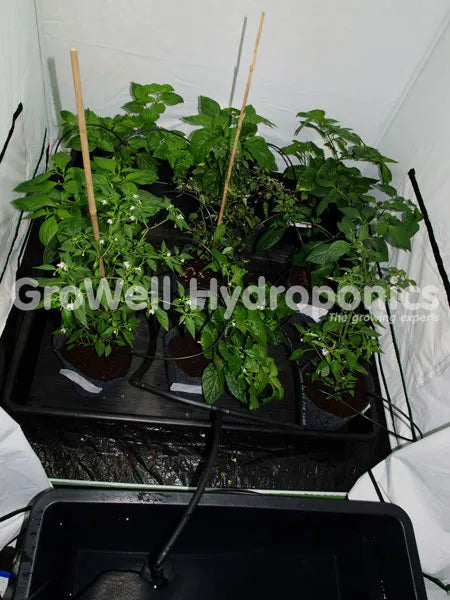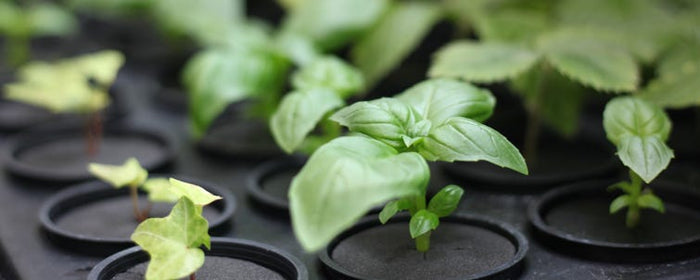
9 Hacks For Mixing Nutrients
Feeding your plants doesn’t have to be a big drama.
Try these 9 hacks to make it super easy.
1. Purify your water
Tap water is full of impurities that can harm your plant.
Unless you remove them, these contaminants can:
- Kill beneficial microbes and bacteria (caused by chlorine)
- Alter your pH
- Affect the concentration of your nutrient feed
- Hinder nutrient uptake
If you’re using anything with living organisms in it, you need to purify your water. That said, we'd recommend this step to all growers.
Some growers:let their water to stand for 24 – 48hrs to remove chlorine (the wider the tank, the better).
Better growers: use water filters to remove almost all impurities.
You can get instant, pure water with an RO filter, giving you complete control of what your plants are being fed.

2. Aim for the right nutrient strength
Nutrient strength is measured in EC (electrical conductivity) or CF (conductivity factor)
CF and EC use different numbers to tell you the same thing (CF = EC x 10)
They tell you how many dissolved salts are in your solution.
The stronger your feed, the higher the CF/EC reading will be.
The exact nutrient strength you aim for depends on a lot of factors. However, on average, you should aim for:
- Young plants = 6 – 12 CF
- Establishing plants = 10 – 16 CF
- Mature plants = 15 – 20 CF

You can check your nutrient strength with a CF truncheon.
Note:
The temperature of your feed can skew your cF reading - a cold nutrient solution will have a lower cF reading then a warm one.
Leave your cF meter in your nutrient solution until it's the same temperature as the feed. This will allow you to take an accurate reading.
3. Select the right nutrient
First of all, you need to know whether you’ve got hard water or soft water.
Use a CF meter:
- 0 - 3 CF: soft to moderately soft
- 4 - 5 CF: medium to moderately hard
- 6+ CF: hard to very hard
Some nutrients are designed for use with hard or soft water. Others are universal. It’s up to you which ones you use.
Either way, make sure you pick one that’s specific to your:
- growing media or method (e.g. coco, soil, hydro)
- stage of growth (grow or bloom).

We recommend using the SHOGUN Samurai range, specifically Hydro Nutrients, Coco Nutrients and Terra Nutrients.
4. Control your nutrient temperature
18 – 20oC is a good temperature.
You can check your temperature with a nutrient thermometer.
If you’re growing hydroponically, or using a dripper system, you can use a heater or chiller to control your feed’s temperature.
If you’re hand watering, let your nutrient solution stand until it’s the right temperature before feeding your plants.
Never shock your plants with cold water.

5. Put in Additives Before your Nutrients
Some boosters need to be added directly to your growing media, but most need to be included in your nutrient solution.
Most of the time, you should add boosters and additives first, then top up the solution with your nutrient until you get the right CF reading.

6. Keep your pH between 5.5 and 6.5
The pH of your feed affects your plant’s ability to absorb nutrients (More about pH here).
The best pH to aim for is 6. However a pH between 5.5 and 6.5 is fine.
Use a pH pen to take a reading. If your pH falls outside the safe range, you’ll need to adjust it.
Remember…
… as nutrients are used by your plants, the pH of your feed drifts.
You’ll need to routinely check the pH level of your feed and adjust it if it drifts outside the safe range. Use a Bluelab pH Controller to automate this.

7. Underfeeding and Overfeeding – the signs
Check your plant for signs of being underfed or overfed.
If you spot any of the signs, you’ll need to increase or decrease the strength of your feed.

Signs of Overfeeding
Stage 1: Dark green leaves that are thick and leathery
Stage 2: Leaves start to curl under and look burnt at the tip
Stage 3: The burn progresses and there is necrosis (cell death)
Signs of Underfeeding
Stage 1: Leaves are soft and light green
Stage 2: Uniform, overall yellowing – the whole leaf becomes pale yellow
Stage 3: Yellow leaves falling off – the plant is dying
8. Get a 20 – 30% Run Off
What’s run off?
The feed that gathers underneath your pots after watering.
When using soil and coco, you need 20 – 30% run off
It flushes out minerals, salts and nutrients left over from past feeds.
Without run off:
- Plants are no longer get the right nutrients
- Plants are growing in toxic conditions
- Plant growth is poor
Getting the run off
Do the maths. If you put 1 Litre in, 200 – 300ml should come out. If it doesn’t, keep watering until the ratio is right.

Collecting Run Off
You need to remove run off before it gets reabsorbed by plants:
- The run off will have become stagnant and may contain bacteria
- Your growing media becomes saturated with unoxygenated water
- Some nutrients remain in your growing media
If this happens you’ll get root problems, poor nutrient absorption and even root rot.
Automate it
You can use a dripper to feed plants the exact dose you need for prime run off.
A good collection system will draw any run off instantly, before it gets reabsorbed. We recommend using a RhizoSystem.
9. Change your nutrient tank contents regularly
Most people top up their tank as required with a complete nutrient change:
- Once a week in flowering
- Once every two weeks in vegetative growth
To be more precise, top up your tank as necessary. When you’ve topped it by the reservoir capacity, change the tank.
For example:
If your complete system volume is 120L
- If you top up in early vegetative growth by 10L per day - You will need to change your tank’s contents after 12 Days
- If you top up in early flowering 25L per day - You will need to change your tank’s contents after 5 days





